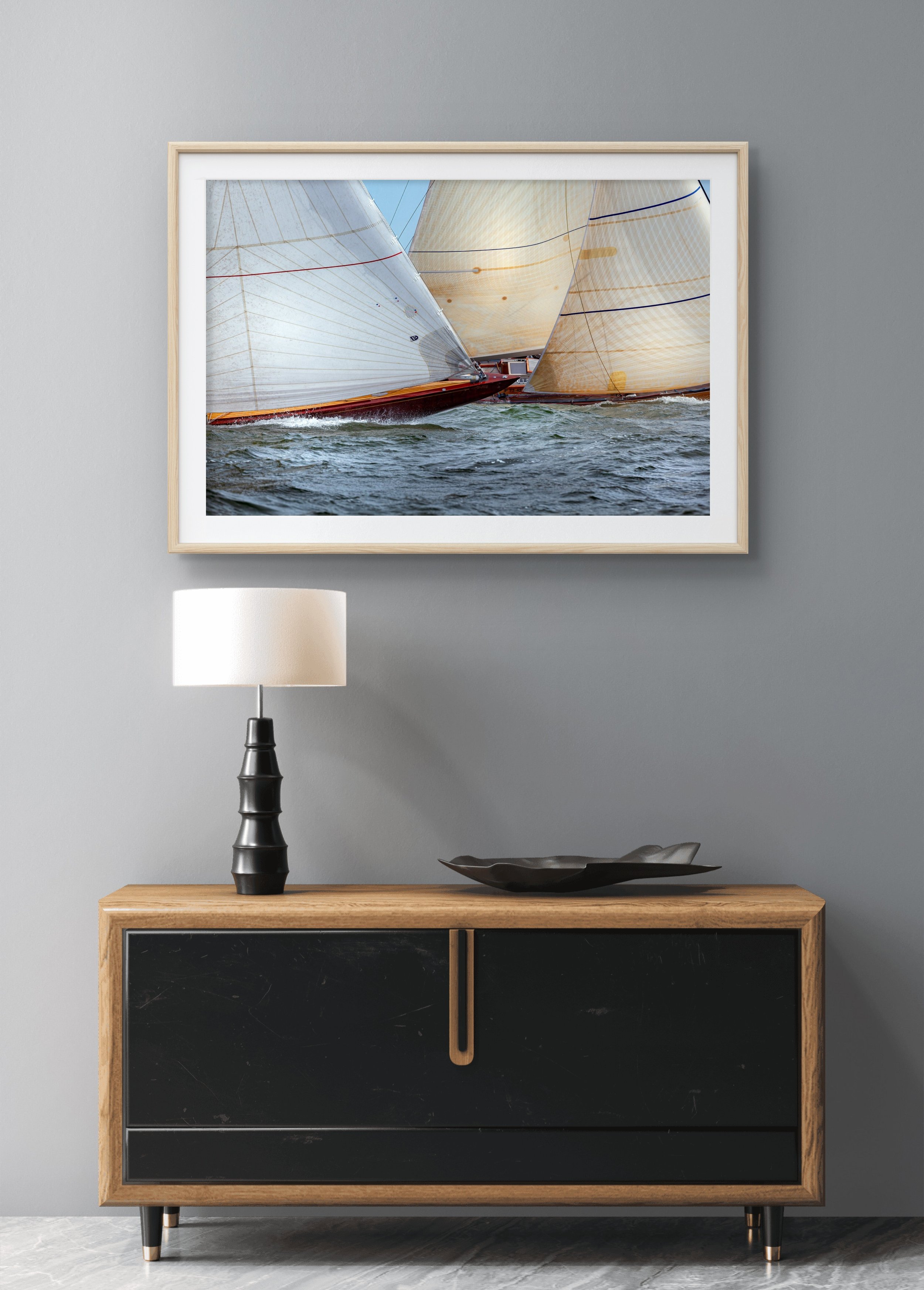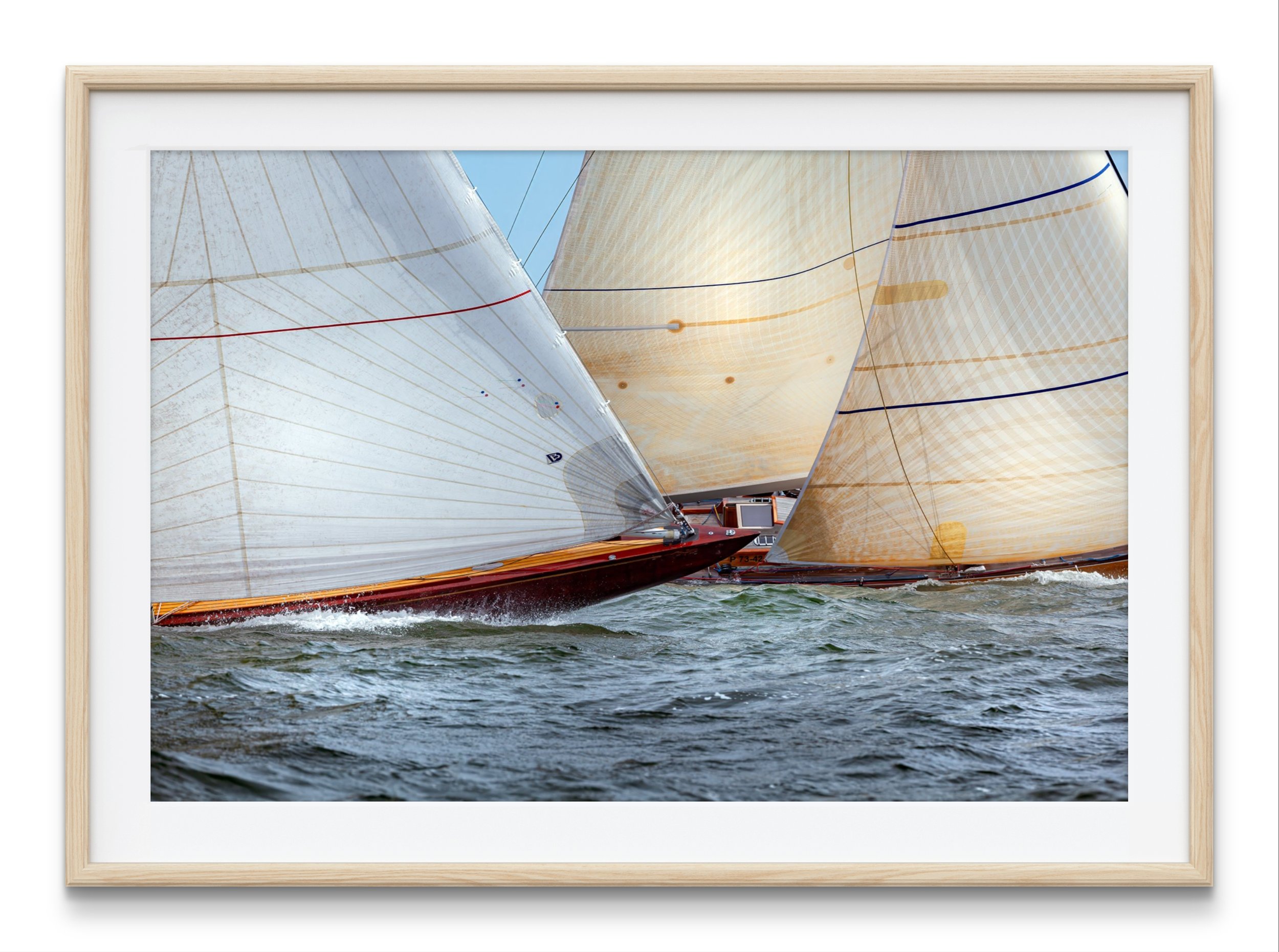8mR
“Eights” are boats that are 14–16 meters long and weigh 8–10 tons. The 8mR class was a competitive sailing category in the Summer Olympics from 1908 to 1936.
Eights, like other metric rule boats, were designed purely as racing vessels but they are also actively sailed as cruising boats. The crew of a classic racing boat consists of seven people, while a modern one has six. Finnish eights generally do not have auxiliary engines, so they are sailed to and from the harbor. The interiors of eights are quite austere compared to the comforts of modern boats.
Finland participated in sailing as a sport for the first time at the 1912 Summer Olympics, under the Russian flag but as an independent nation. The competition included boats from the 6mR, 8mR, 10mR, and 12mR classes. Finland won a bronze medal in the eight class, with Norway taking gold and Sweden silver. Finland's eight was the Lucky Girl, designed by William Fife, which was won in a raffle in 1911 by Gunnar Tallberg's young daughter, Lucy.
Between 1907 and 2010, approximately 500 eights were built worldwide, of which about 180 boats have survived. Eights are still being constructed at a rate of about one boat per year, including both modern builds and replicas based on the designs of older, often destroyed boats. The newest classic eights are the Japanese Aun (J-1) from 2006, the Russian Astra II (RUS-1) from 2007, and Luna (FIN-17) from 2012. Currently, there are 13 registered eights in Finland. FEMA / 8metre.fi
The image is from the Helsinki Regatta in 2012. In the foreground is Astra II, and in the background is Sphinx.
“Eights” are boats that are 14–16 meters long and weigh 8–10 tons. The 8mR class was a competitive sailing category in the Summer Olympics from 1908 to 1936.
Eights, like other metric rule boats, were designed purely as racing vessels but they are also actively sailed as cruising boats. The crew of a classic racing boat consists of seven people, while a modern one has six. Finnish eights generally do not have auxiliary engines, so they are sailed to and from the harbor. The interiors of eights are quite austere compared to the comforts of modern boats.
Finland participated in sailing as a sport for the first time at the 1912 Summer Olympics, under the Russian flag but as an independent nation. The competition included boats from the 6mR, 8mR, 10mR, and 12mR classes. Finland won a bronze medal in the eight class, with Norway taking gold and Sweden silver. Finland's eight was the Lucky Girl, designed by William Fife, which was won in a raffle in 1911 by Gunnar Tallberg's young daughter, Lucy.
Between 1907 and 2010, approximately 500 eights were built worldwide, of which about 180 boats have survived. Eights are still being constructed at a rate of about one boat per year, including both modern builds and replicas based on the designs of older, often destroyed boats. The newest classic eights are the Japanese Aun (J-1) from 2006, the Russian Astra II (RUS-1) from 2007, and Luna (FIN-17) from 2012. Currently, there are 13 registered eights in Finland. FEMA / 8metre.fi
The image is from the Helsinki Regatta in 2012. In the foreground is Astra II, and in the background is Sphinx.
“Eights” are boats that are 14–16 meters long and weigh 8–10 tons. The 8mR class was a competitive sailing category in the Summer Olympics from 1908 to 1936.
Eights, like other metric rule boats, were designed purely as racing vessels but they are also actively sailed as cruising boats. The crew of a classic racing boat consists of seven people, while a modern one has six. Finnish eights generally do not have auxiliary engines, so they are sailed to and from the harbor. The interiors of eights are quite austere compared to the comforts of modern boats.
Finland participated in sailing as a sport for the first time at the 1912 Summer Olympics, under the Russian flag but as an independent nation. The competition included boats from the 6mR, 8mR, 10mR, and 12mR classes. Finland won a bronze medal in the eight class, with Norway taking gold and Sweden silver. Finland's eight was the Lucky Girl, designed by William Fife, which was won in a raffle in 1911 by Gunnar Tallberg's young daughter, Lucy.
Between 1907 and 2010, approximately 500 eights were built worldwide, of which about 180 boats have survived. Eights are still being constructed at a rate of about one boat per year, including both modern builds and replicas based on the designs of older, often destroyed boats. The newest classic eights are the Japanese Aun (J-1) from 2006, the Russian Astra II (RUS-1) from 2007, and Luna (FIN-17) from 2012. Currently, there are 13 registered eights in Finland. FEMA / 8metre.fi
The image is from the Helsinki Regatta in 2012. In the foreground is Astra II, and in the background is Sphinx.




